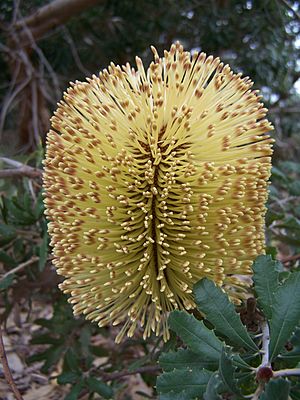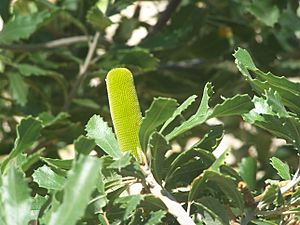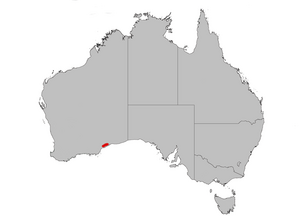Banksia epica facts for kids
Quick facts for kids Banksia epica |
|
|---|---|
 |
|
| Inflorescence of B. epica | |
| Conservation status | |
| Scientific classification | |
| Kingdom: | |
| (unranked): | |
| (unranked): | |
| Order: | |
| Family: | |
| Genus: | |
| Species: |
B. epica
|
| Binomial name | |
| Banksia epica A.S.George
|
|
Banksia epica is a special type of shrub that grows on the south coast of Western Australia. It's a spreading bush with unique wedge-shaped leaves that have serrated edges. Its flowers grow in large, creamy-yellow spikes. This plant can reach up to 3½ metres (about 11½ feet) tall.
You can only find Banksia epica in two small, separate areas in the remote southeast of Western Australia. These areas are close to the western edge of the Great Australian Bight. Both groups of plants grow among coastal heathland on sandy cliff-top dunes. The sand is made of silica.
This Banksia species was only officially described recently. An explorer named Edward John Eyre probably saw it in 1841. However, the first plant samples were not collected until 1973. Scientists finally recognized it as a unique species in 1988. Not much research has been done on Banksia epica since then. This means we don't know a lot about how it lives in nature or how well it can be grown by people. It is closely related to B. media, which is a well-known and often grown plant.
Contents
What Banksia epica Looks Like
Banksia epica grows as a bushy shrub with many branches. It can be anywhere from 30 centimetres (1 foot) to 3½ metres (11½ feet) tall. It has grey bark with cracks. Its dark green leaves are shaped like a wedge. They are about 1½ to 5 centimetres (½ to 2 inches) long and 6 to 15 millimetres (⅛ to ⅔ inches) wide. The edges of the leaves are serrated, meaning they have small teeth.
The flowers of Banksia epica grow in a special shape called a "flower spike". This spike is made of hundreds of flower pairs packed closely together in a spiral around a woody stem. The flower spikes are yellow or creamy-yellow. They are usually 9 to 17 centimetres (3½ to 6½ inches) tall and about 6 centimetres (2½ inches) wide. When the flowers are still buds, they might have green-grey or brownish parts that release pollen.
Each flower has a tube-shaped part called a perianth and a long, thin part called a style. The styles of Banksia epica are straight, not hooked like some other Banksia types. The ends of the styles are first tucked inside the flower. They break free when the flower opens. After flowering, the plant forms a strong, woody "cone" with up to 50 seed pods, called follicles. Old, dried flower parts stay on the "cones", making them look hairy. The follicles have a pretty purple color.
Banksia epica looks a lot like its close relative, B. media. However, B. epica has slightly shorter leaves and bigger flowers. Also, the old flower parts on B. epica's cones are curled and point upwards. On B. media, they are straight and point downwards.
How Banksia epica Was Discovered and Named
Early Sightings and Collections
The first European person to likely see Banksia epica was Edward John Eyre. He was an explorer who wrote about seeing "stunted specimens" of Banksia on May 1, 1841. This was when he was near the western edge of the Great Australian Bight. He was very happy to see them because they suggested a change in the land. Eyre was probably passing through the Toolinna Cove sand patch at that time. Only Banksia epica and B. media grow there. Since he didn't collect any samples, we can't be sure which one he saw.
The first time a sample of Banksia epica was collected for a herbarium (a collection of dried plants) was in October 1973. Ernest Charles Nelson collected it at Toolinna Cove. He thought it was B. media and put it in the herbarium in Canberra under that name.
In 1985, two volunteers, John and Lalage Falconer, believed there were three Banksia species at Point Culver, not just two. They collected leaves and old flowers in January 1986. These samples suggested a new species had been found. But they needed fresh flowers and fruit to officially describe it. In May 1987, John Falconer drove over 2000 kilometres (about 1240 miles) to collect these fresh samples.
Alex George, a botanist, then started preparing a formal description of the new species. He realized that Nelson's sample from Toolinna Cove was also this new, undescribed species. In 1988, he officially described the species. He named it Banksia epica to honor the "epic" journeys of both Eyre and Falconer. So, its full name is Banksia epica A.S.George. Later, it was found that both B. epica and B. media grow at Toolinna Cove.
How Scientists Classify Banksia epica
Scientists group plants into categories to understand their relationships. Banksia epica belongs to the Banksia genus. It is placed in a group called Banksia ser. Cyrtostylis because its flowers are slender. Its closest relatives are B. praemorsa and B. media. These two have slightly shorter flowers.
Scientists like Kevin Thiele and Pauline Ladiges have used cladistics (a method to show evolutionary relationships) to study Banksia plants. Their studies showed that Banksia epica is closely related to B. pilostylis, B. media, and B. praemorsa. This helps us understand its place in the plant family tree.

More recent studies using DNA have also supported these relationships. This means that Banksia epica is consistently grouped with its close relatives.
Where Banksia epica Lives
Banksia epica is only found in two specific places in the eastern part of the Esperance Plains region of Western Australia. These areas are near the western edge of the Great Australian Bight.
The largest group of plants is about 30 kilometres (20 miles) west of Point Culver. In 1989, there were over 2000 plants there. A smaller group, with about 350 plants, is found about 70 kilometres (45 miles) further east at Toolinna Cove. This Toolinna Cove group is the easternmost place where you can find western Banksia species. After that, there are no Banksia plants for over 900 kilometres (550 miles) to the east.
In both locations, Banksia epica grows in heathland on sandy cliff-top dunes. These dunes have deep, white silica sand over limestone. B. epica grows alongside B. media in both places. B. praemorsa is also found at Point Culver. The sand at Toolinna Cove is a bit alkaline. This makes B. epica and B. media special because they are the only Banksia species that can grow in alkaline soil.
These areas are unusual because most of the soil nearby is calcareous (limestone-based). Banksia plants don't like calcareous soils. Scientists think that there might have been a continuous strip of sandy land along the coast a long time ago. This would have given Banksia epica a large habitat. When sea levels rose, this land was submerged. Only the cliff-top dunes remained as suitable homes for the plants.
How Banksia epica Lives and Grows
Birds like the New Holland honeyeater and the yellow-rumped thornbill help pollinate Banksia epica. This means they help the plant make seeds by carrying pollen from one flower to another. Scientists haven't studied this plant much, so there might be other animals and insects that help with pollination too. For example, studies on B. media show that many birds and small mammals help pollinate it. Insects also play a big role in seed production.
Like most plants in the Proteaceae family, Banksia epica has special roots called proteoid roots. These roots have dense clusters of short side roots that form a mat just under the leaves. They help the plant absorb nutrients from poor soils, especially soils that don't have much phosphorus, which is common in Australia.
Banksia epica does not have a lignotuber (a woody swelling at the base of the stem that helps plants regrow after fire). This means that fire probably kills the plant. However, like most Banksia species, it is adapted to release its seeds after a bushfire. This helps new plants grow quickly and the population to recover. The plant is very sensitive to a disease called Phytophthora cinnamomi dieback.
Because there are only two known groups of Banksia epica, it is listed as "Priority Two – Poorly Known Taxa" by the Department of Environment and Conservation. This means it's rare but not currently in danger. Both known groups of plants are inside the Nuytsland Nature Reserve. They are healthy and not disturbed by people. It's also possible that there are more groups of these plants that haven't been found yet, as the area hasn't been fully explored.
Growing Banksia epica
Banksia epica is quite new to being grown by people. Kevin Collins, who runs the Banksia Farm in Albany, Western Australia, was one of the first to grow it. He grew it in loamy clay or sandy gravel. The plant grew well in alkaline soils under these conditions. It has also grown successfully in sandy, alkaline soil near the coast between Mandurah and Kwinana. The Australian National Botanic Gardens in Canberra has also had some success. They planted seeds in 1996. Seedlings that were planted in areas with good drainage grew to about a metre (3 feet) tall by 2002 and flowered a lot. However, seedlings in poorly drained areas died.
You can grow Banksia epica from seeds or from cuttings. The seeds don't need any special treatment to grow. They usually take between 14 to 49 days to germinate (sprout). If you want to grow Banksia epica, experts suggest treating it like B. media and B. praemorsa. This means planting it in a sunny spot with soil that drains water well. You should only prune it lightly, making sure not to cut below the green leaves.
See also
 In Spanish: Banksia epica para niños
In Spanish: Banksia epica para niños





